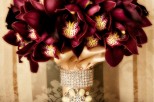
The wedding bouquet. Gorgeous, sweet smelling, traditional. We are posting some of our favorite bouquets from past weddings and hopefully give you inspiration for yours. Here is some history about the bridal bouquet.
“This tradition has ancient roots, and believe it or not, back then, beauty was not a consideration in the wedding bouquet. Garlic was a popular item to carry down the aisle, and I have a feeling that gave an entirely different effect (and smell!) during the wedding procession.
The custom of carrying bouquets originated in ancient times, when it was believed that carrying or wearing strong-smelling herbs and spices would ward off evil spirits, ill health and bad luck. Later, Romans extended this tradition, when the bride and groom both wore garland made of herbs and spices that were expected to bring good luck and fertility. An actual bouquet came to symbolize a bride in bloom.
Traditional Celtic bouquets included ivy, thistle and heather. If a bride carried sage, the flower of wisdom, she was to become wise. If she carried dill, the flower of lust, well, she became lusty (if that’s a word). Flower girls would carry sheaves of wheat, which symbolized growth and fertility.
It is believed that “the flower language” originated in Turkey, where flowers and flower scents were often used by lovers to exchange messages to each other. Each flower came to have its own meaning, and flowers important to a couple during their courtship were incorporated into the bridal bouquet.
During the Victorian Era, these associations were adapted into the wedding ceremony, but edible flowers remained a part of the bouquet. Dill was consumed by both the bride and groom to increase desire and fertility (yet again!). Different-colored flowers also had specific meanings; for example, white flowers symbolized purity, ivy meant fidelity and orange meant happiness and fertility. Lots of fertility talk in those days!
In modern days, though, it is generally accepted that a bride chooses flowers that she likes or that match her wedding theme. Now that you know a little more about the bouquet’s history, maybe you can incorporate a bit of ancient tradition into yours!”
We found this interesting post on the history of the bridal bouquet on the Atebellum Oaks Venue blog by Autumn Morgan.
Enjoy the photos, and if you want to know the florist who created the bouquet, leave us a comment.














































.png)

.png)

.png)

.jpg)